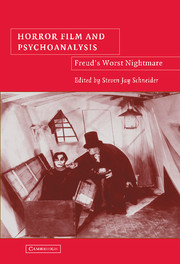Book contents
- Frontmatter
- Contents
- Acknowledgments
- Foreword: “What Lies Beneath?”
- Introduction: “Psychoanalysis in/and/of the Horror Film”
- PART ONE THE QUESTION OF HORROR-PLEASURE
- PART TWO THEORIZING THE UNCANNY
- PART THREE REPRESENTING PSYCHOANALYSIS
- PART FOUR NEW DIRECTIONS
- Afterword: Psychoanalysis and the Horror Film
- About the Contributors
- Bibliography
- Index
Afterword: Psychoanalysis and the Horror Film
Published online by Cambridge University Press: 14 July 2009
- Frontmatter
- Contents
- Acknowledgments
- Foreword: “What Lies Beneath?”
- Introduction: “Psychoanalysis in/and/of the Horror Film”
- PART ONE THE QUESTION OF HORROR-PLEASURE
- PART TWO THEORIZING THE UNCANNY
- PART THREE REPRESENTING PSYCHOANALYSIS
- PART FOUR NEW DIRECTIONS
- Afterword: Psychoanalysis and the Horror Film
- About the Contributors
- Bibliography
- Index
Summary
Because I have expressed reservations about the application of psychoanalysis to film studies in general (Carroll 1988) and to the horror film in particular (Carroll 1990), I have been invited to contribute a comment to this volume on the relevance of psychoanalysis to the horror film. The editor's intention to include dissenting voices in this anthology is as laudable as it is generous and frankly unexpected. But I don't know for whom this opportunity is scarier: me or the psychoanalysts. For I must enter the lair of the Other, while they must suffer the presence of a wolf in philosopher's clothing. I guess it all depends on who you think the monster really is.
Is psychoanalysis relevant to the analysis of the horror film? I think that the simple answer to this question is “Of course.” It is certainly relevant, even apposite, to the analysis of many horror films, because many horror films presuppose, implicitly or explicitly, psychoanalytic concepts and imagery. Forbidden Planet (1956), for example, is frankly Freudian. Its monster is called the Id, a phenomenon explained in explicitly psychoanalytic terms within the world of the fiction. Anyone interpreting Forbidden Planet is thereby licensed to explicate the film psychoanalytically for the same reason that an exegete of Eisenstein's The General Line (1929) would be correct in adverting to Marxist ideology. In both cases, the hermeneutical warrant is historicist.
- Type
- Chapter
- Information
- Horror Film and PsychoanalysisFreud's Worst Nightmare, pp. 257 - 270Publisher: Cambridge University PressPrint publication year: 2004
- 3
- Cited by



